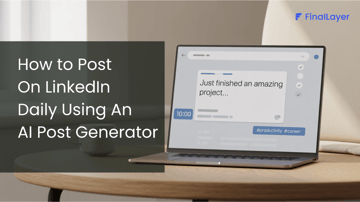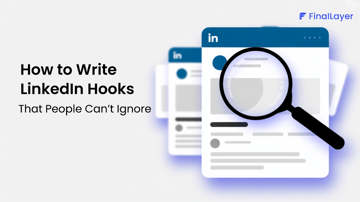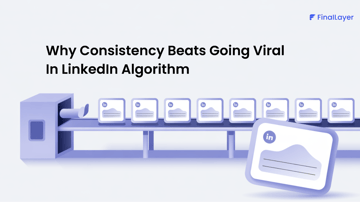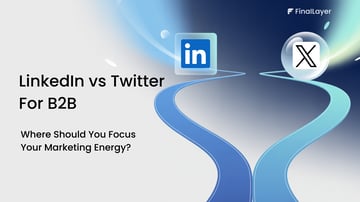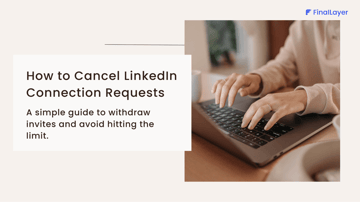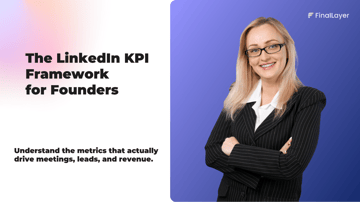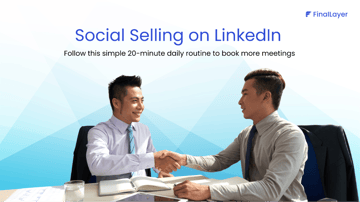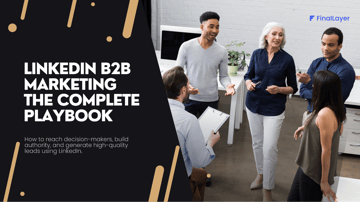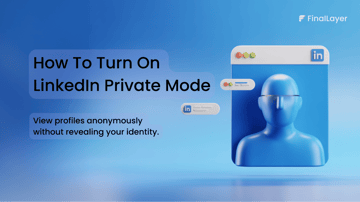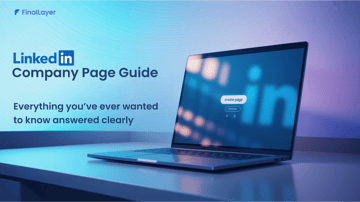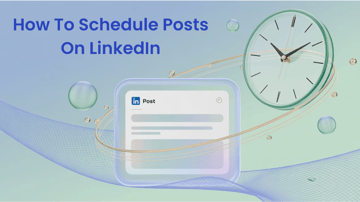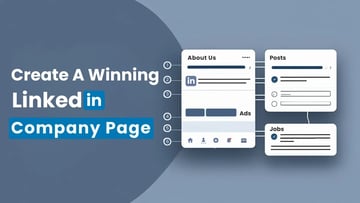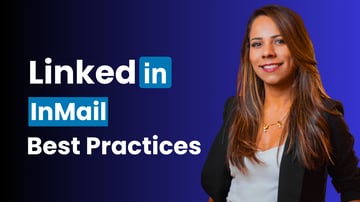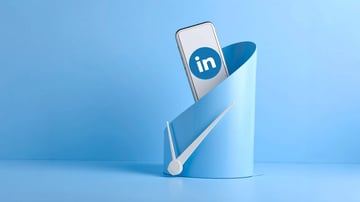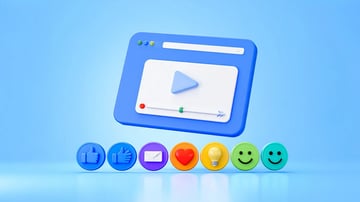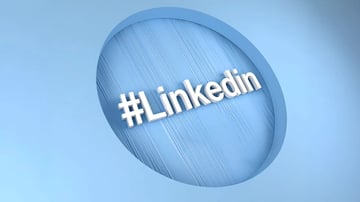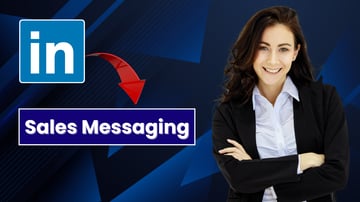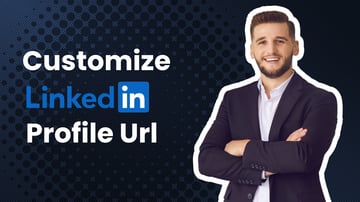After countless conversations with my coworkers, social strategy teams, founders, and friends who've mastered LinkedIn, I've compiled the most valuable insights they've shared about making the platform work effectively. These are the strategies that have helped them generate millions in inbound revenue and establish themselves as authorities in their industries.
I've distilled these conversations into 45 actionable lessons that can transform your LinkedIn strategy and help you leverage the platform to grow your business. Let's dive in.
Build Your Content Foundation
1. Coin your own phrases and terms
Creating your own terminology is a powerful way to establish authority. When you develop phrases that resonate with your audience, they'll start using your language, which reinforces your expertise.
2. Develop repeatable formats to reduce friction
Relying on inspiration to strike every time you sit down to write is dangerous. I've experienced that blank-screen paralysis many times, staring at an empty document with no direction. The solution? Create 3-4 repeatable content formats you can lean on when creativity is low. These templates become your safety net on uninspired days.
3. Build your content playbook
Many founders fear repeating themselves, even when they discover winning content that outperforms. This is a mistake. When you find hooks, ideas, or formats that generate exceptional engagement, add them to your playbook and use them strategically and repeatedly.
If you are struggling with finding the right hook and ideas and spending lots of time on them, then I have a solution for you. Yes, FinalLayer is the platform where you can easily generate your LinkedIn post( Text post/ Video post) by choosing the right hook and ideas in less than 10 minutes.
4. Create a content ecosystem
Once you're active on LinkedIn, expand your presence by encouraging other team members to post consistently. When your leadership team and employees are all sharing content, you create the impression that you're everywhere on the platform. Your target audience shouldn't be able to scroll through LinkedIn without encountering something from you or your company.
5. Incorporate strategic personal content
Your personal interests humanize you and provide connection points with your audience. You don't need to overshare simply identify 1-3 aspects of your personal life to occasionally weave into your professional content. Whether it's fitness, favorite books, or travel plans, these details often spark conversations and create memorable touchpoints.
Optimize Your Content Strategy
6. Answer the golden question
You must be able to clearly articulate why someone in your target audience should follow you. If you can't answer this in one sentence, you have work to do. People follow me to learn about SEO and content writing; it's that simple. Don't try to be known for multiple things initially; start focused, then gradually expand.
7. Use monetary figures in your hooks
Specific numbers; especially impressive monetary amounts; stop people from scrolling. When you have specific figures from your experience or case studies, incorporate them into your hooks to capture attention. Even third-party case study posts perform well when framed around concrete numbers.
8. Leverage credibility jacking
Use popular figures and companies in your content to borrow their credibility and get readers to stop scrolling. For example, writing about a well-known company's strategy can help capture attention from people who might not know you yet but recognize the brand name.
9. Tastefully utilize negativity bias
Humans are wired to pay attention to negative information. You can strategically use this in your content to drive engagement without being excessive. Framing problems before solutions often captures more attention than purely positive messaging.
10. Invest disproportionate time in your hooks
The first 1-3 sentences of your post are by far the most important part. Write at least three variations of every hook; this is non-negotiable with my team. I've seen excellent content buried beneath poor hooks too many times.
Master Content Creation
11. Look for winning templates
Certain content templates consistently perform well on LinkedIn. For instance, Tommy Clark's "I was talking to a $25M CEO and this is what they told me" format had a tremendous run recently. Identify these patterns in your content and adapt them to your content strategy.
12. Use relevant media when possible
While text-only posts can work well, content with relevant visuals typically performs better. Whether it's photos, graphics, carousels, or short-form video, adding visual elements enhances engagement. For example, if you are talking about E-E-A-T principle of google indexing then including a video explaining the same principle is going to add authenticity and visual interest.
13. Experiment with lead magnet posts
A format currently crushing it on LinkedIn is the lead magnet post. Offer valuable resources (PDFs, videos, guides) that people can access by commenting on your post. This drives engagement and visibility while potentially collecting leads and email signups.
14. Focus on early engagement
The first 60 minutes determine a post's trajectory. For important announcements like fundraising news or product launches, consider sharing the link with team members, your network, and friends who can quickly engage to build initial momentum.
15. Write for one specific person
Don't address a hypothetical audience; write as if you're speaking directly to one individual. This person should represent your ideal customer profile. This approach makes your content more relatable and focused.
16. Commit to at least six months
Consistency builds trust. If you post for just a month and then give up when you don't see immediate traction, LinkedIn won't work for you. The platform can transform your business, but only if you commit to consistent content creation for at least six months.
Strategic Content Planning
17. Build a balanced content funnel
Create a mix of top, middle, and bottom-funnel content in your strategy. This approach helps you both expand your audience (top-funnel) and convert existing followers (bottom-funnel). Many founders are focusing too heavily on one end of this spectrum.
18. Post five times per week
If you're serious about generating leads through LinkedIn, posting once or twice weekly isn't sufficient. Five posts per week provide enough data points to quickly learn what resonates with your audience, helping you iterate faster and achieve results sooner.
19. Find your Content Market Fit (CMF)
Content that works has three overlapping elements: it's relevant to your product, important to your target audience, and aligned with your credibility as a founder. The sweet spot is where these three circles intersect in a Venn diagram.
20. Choose content formats that suit you
Select content formats you can consistently produce without burning out. I'm naturally a writer who can tolerate long-form video, but I don't enjoy creating short-form vertical video. Know your strengths and preferences to maintain consistency.
Focus on Business Growth
21. Chase customers, not clout
For any business, you don't need a massive audience. Focus on attracting the right people who have the budget to buy your product. Leave clout-chasing to influencers and concentrate on generating qualified leads.
22. Don't pitch in every post
While you should focus on potential customers, avoid constant pitching. Position yourself as a valuable resource by consistently offering helpful content. Build goodwill first, then introduce sales messaging when you've established trust.
23. Prioritize founder-led content
Founder content typically outperforms company content. People prefer following individuals over brands; it's easier to build trust this way, especially for early-stage companies without strong brand recognition. Even established brands like Airbnb and Shopify leverage founder communications.
Optimize Your Profile
24. Ensure your link-in-bio leads to the right place
Direct traffic to the next logical step in your funnel. This might be a newsletter signup, a demo booking page, or your homepage. Make sure this basic element is properly configured.
25. Utilize featured links strategically
Use 1-2 featured links that guide visitors to your next conversion step and showcase social proof. One link might lead to a demo or lead magnet, while another could highlight a case study demonstrating your results.
26. Add images to featured links
Treat featured link images like YouTube thumbnails; use visuals to increase click-through rates. Add social proof elements and clear value propositions to encourage profile visitors to take the next step.
27. Keep your "About" section concise
Don't overthink this; no one reads lengthy bios. Limit yourself to 4-6 sentences total: 1-2 lines about your product, 1-2 lines of social proof, and 1-2 lines explaining what to expect from your profile.
28. Don't obsess over header images
While you can use branded headers, their impact is minimal compared to other profile elements. Focus your energy on more influential aspects of your profile.
29. Track traffic with UTM links
Add UTM parameters to all profile links to monitor the traffic you're generating from LinkedIn. Apply these to your main bio link, featured links, and profile button links.
Treat your profile as a Landing page
30. Optimize your profile for conversions
When people discover your content in their feed, some will visit your profile, and a percentage of those visitors will follow you. Optimize your profile to maximize these conversion rates.
31. Use a clear profile picture
Your photo should be shoulders-up against a solid background. Avoid full-body shots or selfies with busy backgrounds that make you difficult to recognize in the timeline.
32. Craft a strategic headline
Your headline should clearly communicate your answer to the golden question (why someone should follow you). A simple formula is: Role + Company + Value Proposition.
Content Creation Strategies
33. Incorporate personal narratives
Shift from "how-to" content to "how I" content. Your stories establish credibility and differentiate you from competitors. For example, instead of generic advice about content marketing, share how you grew a startup's content strategy to generate numbers in the pipeline within 90 days.
34. Tag strategic accounts
When someone comments on your content, it gets amplified to their audience. Tag relevant accounts; especially when featuring them positively in case studies; to expand your reach even with a small initial following.
35. Create "Slack group-worthy" content
Produce content so helpful and insightful that readers can't help but share it with colleagues or supervisors. Ask yourself: "Would someone find this valuable enough to forward to their team?" This filter helps create more shareable content.
36. Embrace scrappy graphics
Overly branded, corporate-looking graphics often perform poorly placed graphics because they look like advertisements. Instead, use more authentic visuals like notes app screenshots or real-life photos that feel native to social platforms.
Building Your Audience
37. Spend 15-20 minutes daily engaging with others
Posting is only half the battle. Comment on content from two groups: ideal customer accounts and influencers your target audience follows. This increases your profile views and ultimately drives follower growth.
38. Send 20 outbound connection requests daily
When someone accepts your connection request, they're effectively opting in to see your content. Build a list of people in your ideal customer profile and manually send them connection requests. As they connect, they'll start seeing your content regularly.
39. Use profile views as outreach signals
Monitor who's viewing your profile. When someone from your target audience checks out your profile, send them a connection request and consider following up with a personalized Loom video. Keep these to 60-90 seconds, offering genuine value before any soft call-to-action.
40. Find your creative flow state
Find what helps you write better content, whether it's certain music, a specific environment, or your own unique ritual. Experiment until you discover what puts you in the optimal state for creating engaging LinkedIn content.
Optimization and Consistency Techniques
41. Analyze your top-performing content regularly
When growing on LinkedIn, you need to be strategic about what you post. The best way to know what works is to regularly review your own data. Your audience is showing you exactly what they want through their engagement behavior, and by analyzing this information, you can continually refine your content strategy to give them more of what they respond to.
42. Create conversation-starting polls
LinkedIn polls offer a powerful way to boost engagement with minimal effort. The beauty of polls is that they provide a low-friction way for your connections to interact with your content. What makes polls especially effective is asking participants to explain their choices in the comments. The LinkedIn algorithm favors posts with high engagement, so well-designed polls often receive significantly more visibility than standard posts.
43. Repurpose content strategically
Creating fresh content consistently can be challenging, which is why smart LinkedIn users leverage content repurposing. Rather than starting from scratch for every post, look at your existing longer-form content - articles, case studies, webinars, podcasts for LinkedIn post ideas. Repurposing helps your core messages reach a wider segment of your audience through multiple touchpoints, reinforcing your expertise on specific topics.
44. Use the "Five Friends" feedback method
Even experienced content creators can develop blind spots about their own writing. What seems perfectly clear to you might confuse others, and what you find compelling might not resonate with your audience. The Five Friends method addresses this by having trusted connections review important posts before you publish them.
45. Create content batches to maintain consistency
Consistency is crucial for LinkedIn growth, but trying to create content on a daily basis often leads to burnout or missed posting days. Content batching solves this problem by dedicating focused blocks of time to create multiple posts at once. When you set aside 2-3 hours weekly specifically for LinkedIn content creation, you enter a productive flow state where ideas connect more easily and each subsequent post becomes faster to write.
Final Thoughts
Every connection, comment, and thoughtful post brings you one step closer to meaningful business growth. These lessons have been gleaned from observing the most successful founders and marketers on the platform. Start today by implementing just three strategies from this list. Focus on providing genuine value, maintain consistency for six months, and watch as opportunities multiply. But remember what works for others won't automatically work for you. Test these strategies, measure your results, and refine your approach based on what resonates with your specific audience.






